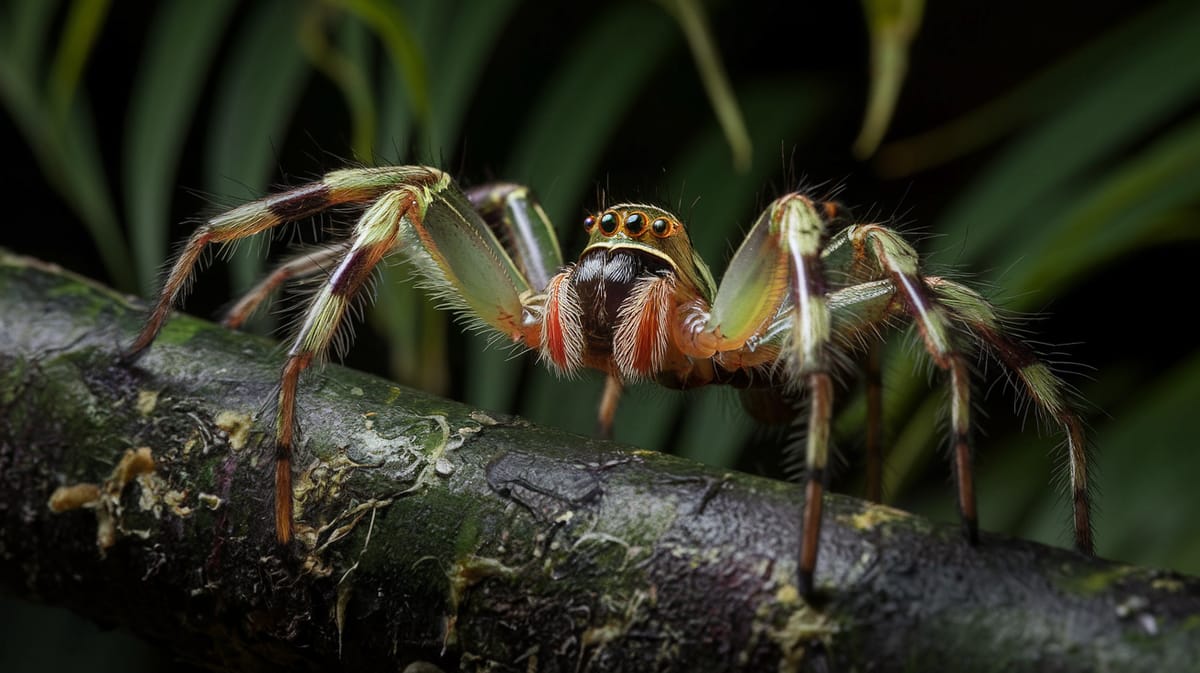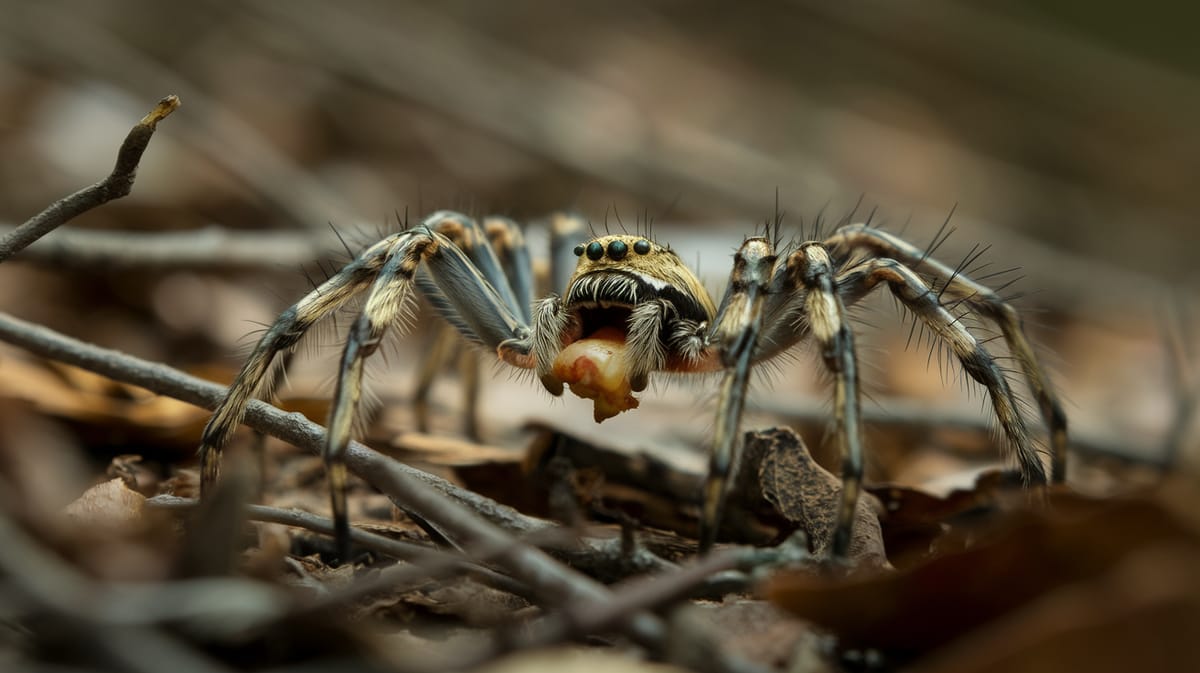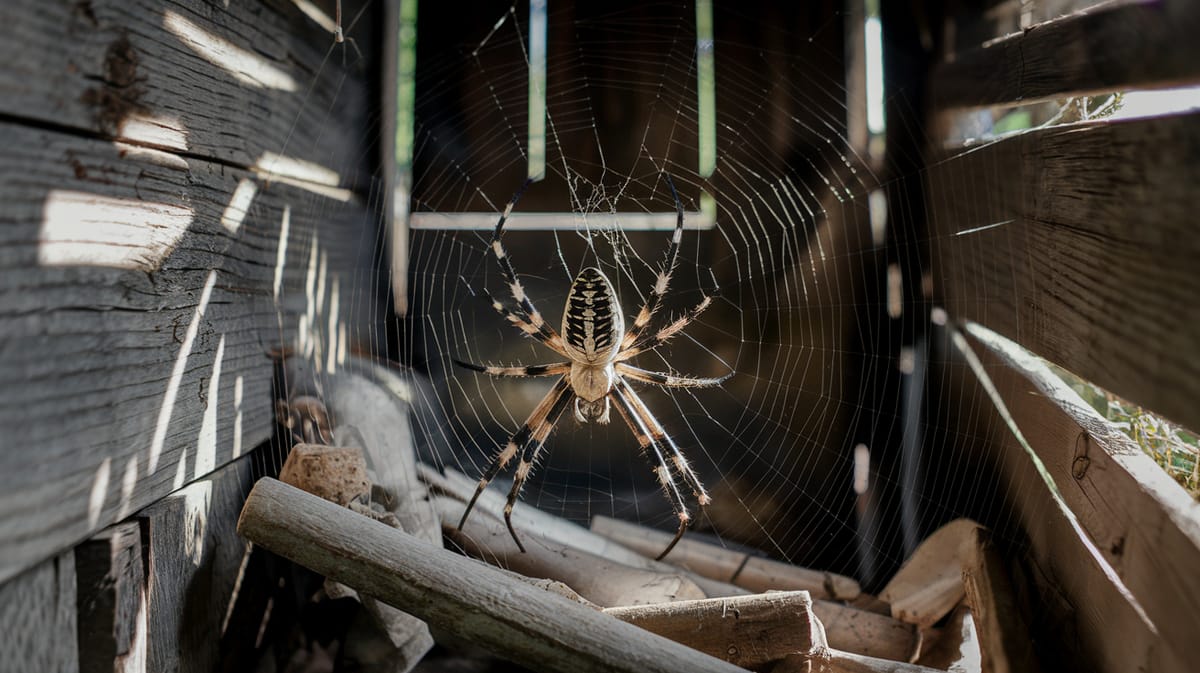Brazilian Wandering Spider
Eight-legged and notorious, the Brazilian Wandering Spider prowls the forest floor with unmatched agility and venom potency. A nocturnal predator, it plays a vital role in controlling insect populations.

Key Insights at a Glance
Did You Know?
Taxonomy & Classification
Renowned for their potent venom and nocturnal hunting, Brazilian Wandering Spiders have evolved as formidable predators in tropical regions. Let's understand the evolutionary journey and classification of these remarkable predators.
Species Diversity
The genus Phoneutria includes eight species, all known for their aggressive behavior and presence primarily in Central and South America.
Evolutionary Adaptations
These spiders developed potent venom and agility, traits that have helped them thrive since potentially diverging from other spiders millions of years ago.
Lifecycle and Growth
A remarkable journey of transformation from Egg to Adult.
Egg
Eggs are laid in a silk sac, providing protection and warmth until the spiderlings emerge ready to face the world.
Spiderling
Spiderlings hatch and disperse, experiencing multiple molts while developing their hunting skills and survival instincts.
Adult
Adults reach full size and develop potent venom, engaging in active hunting and mating to propagate the species.
Dietary Habits
A skilled predator with impressive hunting abilities, this spider adapts its diet to include insects, small vertebrates, and opportunistic prey.
| DIET TYPE | DESCRIPTION |
|---|---|
| Primary Diet | Primarily feeds on insects like crickets, beetles, and other spiders, capturing them with swift, agile movements. |
| Secondary Diet | Consumes small vertebrates such as frogs and lizards, supplementing its diet when these are accessible. |
| Occasional | Occasionally preys on small rodents and birds, taking advantage of unique opportunities in its environment. |

Behaviour and Adaptations
Discover the fascinating traits and adaptations that make the Brazilian Wandering Spider a formidable force in the wild.
Nocturnal Hunting
Highly active at night, the spider excels in hunting under low-light conditions.
Venom Potency
Possesses one of the most potent venoms, capable of quickly immobilizing prey.
Wandering Behavior
Actively roams rather than building webs, increasing encounter opportunities with prey.
Ecosystem Impact
Maintaining ecological balance through the Brazilian Wandering Spider's unique contributions.
Natural Pest Control
Controls populations of insects and small animals, preventing overpopulation.
Food Web Contributor
Serves as prey for larger predators, maintaining food chain dynamics.
Biodiversity Supporter
Promotes biodiversity by regulating prey species, fostering a balanced ecosystem.
Conservation Challenges
Understanding and addressing the major threats to Brazilian Wandering Spider populations.
Habitat Destruction
Deforestation and urbanization reduce the spider's natural habitat and resources.
Chemical Pollution
Pesticides and industrial waste contaminate their environment, impacting health and survival.
Climate Change
Altered weather patterns affect prey availability and ecosystem stability.
Frequently Asked Questions
How long do Brazilian Wandering Spider live?
Brazilian Wandering Spiders typically live for about one to two years in the wild. Their lifespan can vary based on environmental factors and availability of food. In captivity, with optimal conditions, they might live slightly longer.
What do Brazilian Wandering Spider eat?
Brazilian Wandering Spiders are carnivorous and primarily feed on insects, other spiders, and small vertebrates like lizards. They actively hunt their prey rather than using webs to catch it.
Are Brazilian Wandering Spider poisonous?
Yes, Brazilian Wandering Spiders are highly venomous. Their venom contains neurotoxins that can cause serious medical symptoms in humans. While their bites are dangerous, fatalities are rare due to effective medical treatments.
Are Brazilian Wandering Spider endangered?
Brazilian Wandering Spiders are not currently listed as endangered. They have a wide distribution in South and Central America, which helps maintain their population levels despite habitat loss and other threats.
What do Brazilian Wandering Spider symbolize?
In some cultures, Brazilian Wandering Spiders symbolize danger and fear due to their venomous nature. They may also represent survival and adaptability, given their ability to thrive in various environments.
Do Brazilian Wandering Spider bite?
Yes, Brazilian Wandering Spiders can bite if they feel threatened. Their bite can deliver potent venom, causing severe pain and medical symptoms. Immediate medical attention is recommended if bitten.
What color are Brazilian Wandering Spider?
Brazilian Wandering Spiders are typically brown or gray with distinctive black spots or markings. Their coloration helps them blend into their natural surroundings, aiding in hunting and avoiding predators.
Does a Brazilian Wandering Spider have wings?
No, Brazilian Wandering Spiders do not have wings. They are a type of ground-dwelling spider that relies on their legs for movement and hunting, rather than flying.
What does a Brazilian Wandering Spider look like?
Brazilian Wandering Spiders have a robust body, long legs, and a hairy appearance. They are often brown or gray with black spots or markings. Their size can range from 1.5 to 5 inches, including leg span.
Is a Brazilian Wandering Spider an insect?
No, a Brazilian Wandering Spider is not an insect. It is an arachnid, which is a different class of arthropods. Arachnids have eight legs and no antennae, whereas insects have six legs and antennae.
Related Insects
Discover insects with similar characteristics to Brazilian Wandering Spider - including shared habitats, diets, and taxonomic classifications
Share this profile
Help others discover Brazilian Wandering Spider
